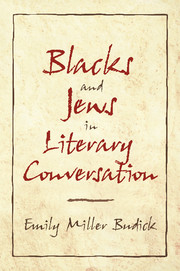Book contents
- Frontmatter
- Contents
- Acknowledgments
- Introduction: “Because you were strangers in the land”
- 1 Mutual Textual Constructions of Black–Jewish Identity
- 2 Crisis and Commentary in African–Jewish American Relations
- 3 Race, Homeland, and the Construction of Jewish American Identity
- 4 Cultural Autonomy, Supersessionism, and the Jew in African American Fiction
- 5 “The Anguish of the Other”: On the Mutual Displacements, Appropriations, and Accommodations of Culture (Toni Morrison, Cynthia Ozick, William Styron, Philip Roth, Grace Paley, and the Jewish–American–Israeli Critic)
- Notes
- Index
3 - Race, Homeland, and the Construction of Jewish American Identity
Published online by Cambridge University Press: 06 July 2010
- Frontmatter
- Contents
- Acknowledgments
- Introduction: “Because you were strangers in the land”
- 1 Mutual Textual Constructions of Black–Jewish Identity
- 2 Crisis and Commentary in African–Jewish American Relations
- 3 Race, Homeland, and the Construction of Jewish American Identity
- 4 Cultural Autonomy, Supersessionism, and the Jew in African American Fiction
- 5 “The Anguish of the Other”: On the Mutual Displacements, Appropriations, and Accommodations of Culture (Toni Morrison, Cynthia Ozick, William Styron, Philip Roth, Grace Paley, and the Jewish–American–Israeli Critic)
- Notes
- Index
Summary
A Diasporist … is a Jew for whom authenticity as a Jew means living in the Diaspora, for whom the Diaspora is the normal condition and Zionism is the abnormality – a Diasporist is a Jew who believes that the only Jews who matter are the Jews of the Diaspora, that the only Jews who survive are the Jews of the Diaspora, that the only Jews who are Jews are the Jews of the Diaspora.
Philip Roth, Operation ShylockWhen working-class Newarkian Neil Klugman in Goodbye, Columbus phones affluent Jewish American princess Brenda Patimkin and launches into his “you-don't-know-my-name-but-I-held-your-glasses-for-you-at-the-club” “speech,” she answers him, quite naturally enough, by asking him what he looks like. “I'm … dark,” he answers; “Are you a Negro?” she responds. “No,” he replies. Pages later the conversation repeats, in painfully truncated form. Asked what his cousin looks like, he responds: “She's dark-” “Is she-” “No.”
How are we to understand the placement of this conversation in a novel essentially concerned not with blacks but with Jewish Americans? And what, further, are we to do with that “no,” Neil's refusal of likeness between himself and the “Negro”? The answers to both questions might seem obvious enough, and wholly objectionable, on both Neil's part and on Roth's as well, were it not for an even more dominant and pervasive pattern through the novel. This is the book's affirmation of a genuine similarity, verging on consanguinity, between blacks and Jews, as much on Neil's part as on Roth's.
- Type
- Chapter
- Information
- Blacks and Jews in Literary Conversation , pp. 119 - 160Publisher: Cambridge University PressPrint publication year: 1998

